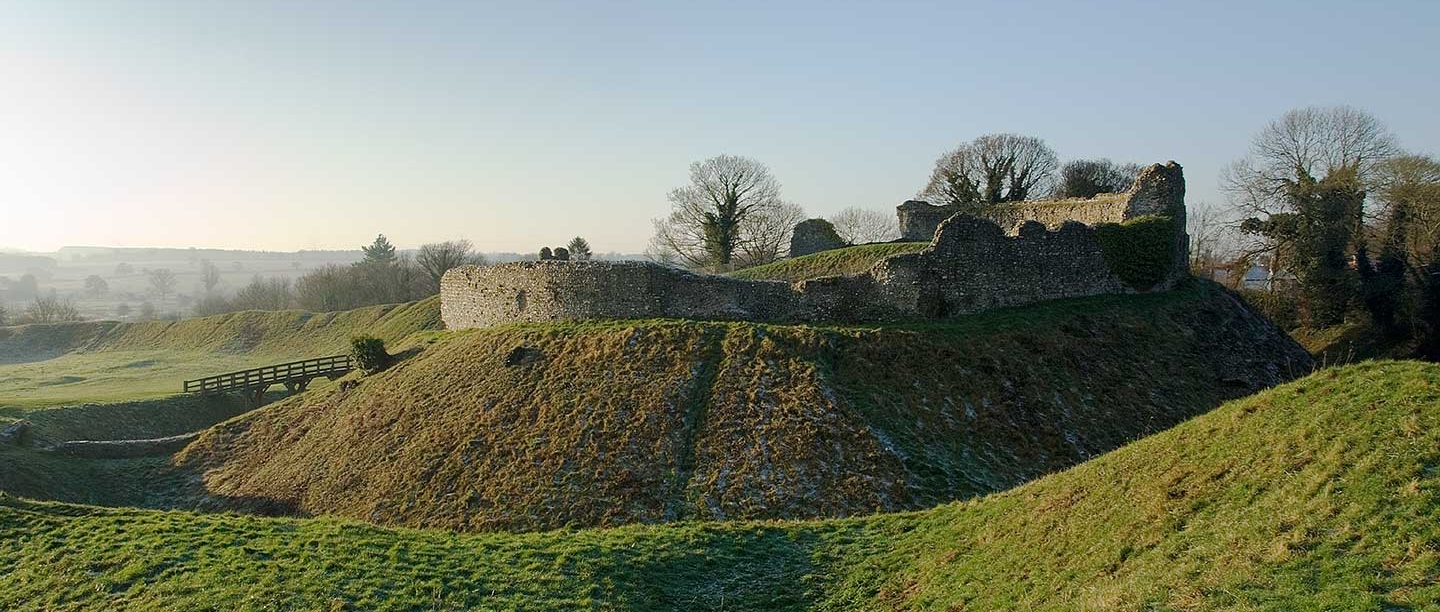The Warennes and the Early Castle
By 1066 there was already a settlement at Acre, together with a church[1] and the principal house of a substantial landowner called Toki, possibly on the site of the castle.[2] As with most of his class, Toki was soon dispossessed by the new Norman regime. His lands were briefly held by a Flemish family ennobled by William the Conqueror,[3] and their Norfolk property descended to an heiress, Gundrada.[4] It was through her that William I de Warenne, her husband, gained control of Castle Acre in about 1070.[5]
Warenne’s family are known of in Normandy from the 1030s,[6] but William had been vastly enriched after the Conquest with territories in Yorkshire and Sussex, and was later raised to the earldom of Surrey.[7] He chose Acre as his Norfolk base, thanks to its central position within his East Anglian landholdings, and built a castle there to provide a secure residence, an administrative centre and a powerful and permanent reminder of his authority.
The castle consisted of three main earthwork enclosures, one of them containing a stone-built house. It was probably habitable by 1085, as Gundrada died at Castle Acre on 27 May.[8] Between 1081 and 1085 Warenne brought to the castle a small community of Cluniac monks from his own foundation at Lewes (Sussex).[9]
The Castle and its medieval owners
Warenne was succeeded in 1088 by his son William (William II de Warenne, 2nd Earl of Surrey, also styled Earl Warenne), who enjoyed a prominent military and political career on a par with his father’s. It was his grant of a new site and increased resources that enabled the monks to begin the existing buildings of Castle Acre Priory.[10]
William’s son, another William (William III de Warenne), inherited in 1138, during the struggle for the throne between Matilda, daughter and acknowledged successor of Henry I (r.1100–1135), and her cousin King Stephen (r.1135–54). It was in those uncertain times that William heightened the castle’s earth ramparts, crowned them with a stone wall, and began to convert the stone house into an independently defensible ‘great tower’. It was probably he too who replanned the town and surrounded it with the massive earth banks and deep ditches which largely survive.[11] William continued the family’s military tradition, and was killed in 1148 serving on the Second Crusade.[12]
READ MORE ABOUT CASTLE ACRE PRIORYWarenne’s heir was his daughter, Isabel, whose two husbands successively became the 4th and 5th Earls of Surrey. The second, Hamelin Plantagenet, was the half-brother of Henry II (r.1154–89); he was an important ally in Henry’s struggles with his sons, and later of Henry’s third son, King Richard (‘the Lionheart’, r.1189–99). It was probably Hamelin who built the town’s two stone gatehouses and resumed work on the unfinished great tower.
Hamelin’s son and grandson were also prominent military and political figures, entertaining both Henry III (r.1216–72) and Edward I (r.1272–1307) at Castle Acre.[13] John, the 8th Earl and the last of the line, was succeeded in 1347 by his nephew, Richard Fitzalan, Earl of Arundel,[14] whose descendants held Castle Acre until 1558. By then, however, as indicated in a survey of 1397, the castle was little used and perhaps derelict.[15]
Download a plan of the castle
Post-medieval history
In 1558 the castle was sold by Thomas Howard, 4th Duke of Norfolk, to Thomas Gresham, and then by his widow to Thomas Cecil (son of Elizabeth I’s lord high treasurer). In 1615 it was bought by the outstanding lawyer and politician Sir Edward Coke, to whose descendants’ business the freehold belongs today.[16]
Interestingly, given that the building had little practical use, Coke ordered some substantial repairs, including the ‘finishing up of eleven battlements and other masons’ work’.[17] But from at least the later 17th century until the early 20th the site was used for grazing and the masonry was ruthlessly quarried for building and road-making.
The town, meanwhile, with no resident lord, nor, since 1537, its priory, had lost its late medieval prosperity. In 1582 there were 80 houses in the village, but 17 were empty, and its two guildhalls, centres of medieval commerce, were destroyed or in ruins.[18]
Antiquarian interest and recent history
Antiquarian interest in the castle began in the 18th century. The Buck brothers published their view in the 1730s,[19] and the castle was visited in 1734 by Norfolk’s county historian Francis Blomefield, who found much of its ‘lofty embattled wall’ intact,[20] and made a fascinating sketch map of the castle, town and priory (above).[21] Exploratory holes were dug in the late 18th century,[22] and important notes and drawings were made by the local clergyman and antiquary Thomas Kerrich in 1782.[23] Further investigations took place in the 1850s[24] and 1930s.[25]
Systematic archaeological study, however, began with Jonathan Coad and Anthony Streeten’s excavations of 1972–83 after the 5th Earl of Leicester had placed the castle in state guardianship in 1971.[26]
About the Author
Edward Impey is a specialist in aspects of medieval architecture and history. Formerly Director of Heritage Protection and Planning at English Heritage, he is now Master of the Royal Armouries. He is also the author of the English Heritage Red Guide to Castle Acre Priory and Castle.
Read more about the castle and bailey gate
DOWNLOAD A PLAN OF CASTLE ACRE CASTLE
DOWNLOAD A PLAN OF THE CASTLE’S DEVELOPMENT
Buy the guidebook to Castle Acre Priory and Castle